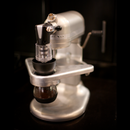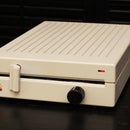Introduction: Retro Hi-Fi Project
Bought an old Webcor Hi-Fi at a thrift store for 30 bucks . . . it came with a broken record player and a blown out mono tube-amp. I decided out with the old and in with the new! It's now got a Sony 5-disc CD changer and a tripath amp along with a few other goodies. Total project took me about 100 hours over 6-months time. Normally I like to do things with a little more precision, but was too lazy to machine anything, so I just did everything rather crudely in my apartment. Overall sound with the tripath amp is excellent!
Step 1: Scoring a Nifty Lookin Hi-Fi
I found my Hi-Fi at a thrift store in San Francisco's Mission District, but don't just limit your search to thrift stores. Since starting this project, I've seen a lot of these things at antique stores and garage sales. I guess there's not much "perceived" use for low-quality record players and mono-amplifiers!
When buying your retro-stereo, try to have an idea in mind what you want to do with it, and make sure that the layout of your "antique" won't make your modifications impossible. My Hi-Fi originally had volume and tone knobs and a huge blank panel in-between where I'd eventually put the CD control buttons.
Have a vision . . . it'll make your life easier!
Step 2: Exploratory Surgery
Before you get too carried away trying to physically integrate components together, do some electronic layout to make sure cables are long enough . . . and if they're not long enough, make some extensions.
I planned to integrate a Sony 5-disc changer that I no longer used, and spent the better part of an afternoon ripping it apart and figuring out how it worked. The first thing I realized was that I'd need to extend the ribbon cables connecting the display to the main control board. I'd also have to extend the ribbon cable connecting the control board to the changer carousel . . .
Step 3: Eloooongate Cables
I decided to elongate the ribbon cables connecting the display using left over IDE hard drive cabling. Luckily the spacing of the wires were the same (0.100" wire-to-wire). Other common sizes are available . . . check Digikey if you need another spacing.
I tried various ways to strip the ends of the wire, but finally ended up carefully slicing everything with an xacto knife, then pulling. Solder a wire on each end, then do all the wires in between them to help with keeping things aligned. Once everything was soldered up, I encased the connections with a non-conductive epoxy to prevent shorts if the wire were to get kinked.
The second picture shows just how much extension I needed!
Step 4: Extending Control Switches Part-1
The next thing to do is to de-solder those surface-mount control switches (Play, Pause, Stop, FF, etc), and to see if we can extend the wiring for those as well. I intended on mounting the control switches on the front of the Hi-Fi, but keeping the display at the back . . . it's a good thing Sony integrated these things, bleh!
The first picture shows an extension connected to a momentary pushbutton switch. I wanted to make sure the extra wire and crappy switch would still work in controlling the changer (disclaimer, I'm NOT and electrical engineer!)
Step 5: Extending Control Switches Part-2
Once the switch extensions seemed to work, it was time to extend all the controls I wished to use. Upon looking at the PCB layout carefully, I noticed that all the surface-mount control switches terminated to a common bus that I'm guessing was Ground? In any case, this meant that I only had to extend one wire per switch, and one Ground wire, thus saving a bunch of time!
I was a little low on hookup wire, but overstocked on ethernet cable now that Wi-Fi is all the rage . . . if it's good enough to zip the internet to me, it's good enough to press "Play."
Step 6: Mounting Display Bezel
I thought the best place to mount the display panel would be where the original mono-speaker was located.
The first thing to do here was fill in the hole where the speaker was something a little more substantial . . . like 1/4" MDF/fiberboard. Once the MDF cutout fit in the speaker hole perfectly, I cut out an additional rectangle in it for the original Sony display bezel. The old-school speaker fabric can then be cut with an xacto and carefully folded back inside of the bezel cutout (see picture).
Once everything fits snugly, quick! epoxy it all together before something happens! Preferably 5-minute epoxy if you're like me and have a short attention span.
Step 7: Mount Display Behind Bezel
Next up is mounting the display such that it's aligned with the display bezel. The display board had mounting holes all over it, but unfortunately only a few of them had wood beneath them. You can see the screws I used on the left side . . . which unfortunately leaves the display cantilevered. Once again, I took care of this cantilever problem with a dab of 5-minute epoxy.
Step 8: Securing the Guts
The original CD-changer "electronics board" was neatly mounted in the Sony chassis. Unfortunately there was no way the original chassis was going to fit in the Hi-Fi . . .
I ended up driving down to Halted, got analuminum project box, along with other parts that will show up later. The audio signal output wires were directly wired to the board since connectors wouldn't fit in the box, and neurotically I like to solder.
A strain relief was added where the power cord leaves the box, and the entire board was mounted on standoffs with an insulating plastic sheet beneath the power supply section . . . just in case an earthquake flexes the board and shorts the components, thus causing a fire . . . it could happen, I'm in San Francisco.
The areas where the signal/ribbon wires leave the box should be oversized and filed smooth to avoid shorts in this area as well.
The entire box was then mounted to the bottom of the carousel drawer as shown in the second picture to form one big "mass" that is easier to mount in the Hi-Fi console.
Step 9: Filing a Big Hole
The Changer was originally the type that had it's carousel slide in and out. Unfortunately when I removed this from the original chassis, there was a gaping hole in the back that would need to be filled before this would become an aesthetically pleasing top-load carousel.
Regardless of which brand CD changer you use for a project like this, you'll probably have to do some sort of gap filling. Filling these gaps can be done well enough with Lexan/polycarbonate (available at Home Depot or TAP Plastics) painted to match any color. After cutting a piece that fit, I painted the back of it black, waited for the paint to dry, then covered the paint with a layer of duct tape. I knew I'd be squeezing this thing into it's new home, so the tape was just to protect the paint from being scratched off.
Step 10: Adding a Support Frame
The bottom of the original Hi-Fi didn't have much support, even for the cheap plastic record player that it came with. Some sort of reinforcement/framing definitely had to be added before I could mount the CD changer in the console.
The two cross pieces in the picture are 2x2's that were chiseled on the ends and slid into grooves that were already part of the original console. They were positioned to perfectly support the bottom of the metal electronics box.
Step 11: Tidying Things Up
Once the CD Changer's screwed into place, it's time to fill in all the visible gaps. Custom panels were pieced together with 1/4" MDF/fiberboard, then painted black to match the changer.
Life would've been easier to use a single panel to cover the gap seen in the previous step, but I opted to make a small pocket for spare CD storage.
Step 12: Intermission
At this point, everything's nice and neat, but the Hi-Fi/CD changer combo is only an audio source (no integrated amplifier/speakers), and can only be controlled by the changer remote control. Since laziness kicked in, I hooked up a Sonic Impact 5066 amplifier, hooked up some cheap Polk R15's and listened in utter amazement for a few months!
Step 13: Integrating an Amplifier
Once laziness subsided, it was time to integrate the tiny amplifier into the Hi-Fi console. The T-amp is pretty easy to take apart once you realize that there are screws UNDER the removable rubber feet on the amp! Notice how tiny the amp is compared to it's reasonably small housing!
Since the speaker output wires would need to be elongated anyway, I decided to start from scratch instead of simply adding on the the existing wiring.
Step 14: The Volume Knob
If you choose to use the original T-amp volume potentiometer, this is an easy way to stick any knob you want on it.
The end of the was cut off the T-amp volume knob and glued into one of the retro knobs that came with the Hi-Fi.
The T-amp volume potentiometer came with a handy mounting flange that worked perfectly to mount the pot to the Hi-Fi's wood paneling.
Step 15: Adding Speaker Outputs
Gold plated binding posts were added to the back of the Hi-Fi to serve as speaker outputs.
Clean holes can be drilled in wood with Forstner-style bits. These are definitely recommended if the hole will be visible. Standard drill bits will often tear and splinter wood upon entering and exiting regardless of how careful you are!
Once everything's bolted in place, the filtering capacitors that were originally soldered across the outputs of the T-amp are soldered across the binding post outputs.
Step 16: Laying Out the Controls
Before going crazy and drilling holes, it's always best to lay things out to make sure they'll look good . . . oh yeah, and to make sure things will fit as well.
If you've got a lot of time on your hands, or like me, you're terrible at sketching, go the CAD route. Of course good 'ol paper and pencil work fine as well!
Step 17: It's All About the Switches!
Next up is finding/mounting some switches to control the CD changer's functions like Play, Pause, Skip, etc. Once again, I managed to find some cool, retro-looking switches and knobs at Halted. Unfortunately the switches didn't come with any mounting brackets or mounting flanges for that matter!
Luckily, I had some 3/4" MDF lying around, in which I managed to cut out slots for the switches. I spaced the switches out at 0.750 center-to-center, marked my lines with digital calipers, then cut the slots with a jigsaw. Even though great care was taken, I was surprised taking measurements afterwards, that each spacing was off by less than 10/1000ths of an inch!
After the slots were cut, the switches were epoxied into place, along with a flange place that would allow for a flat mounting surface to mate with the Hi-Fi.
Step 18: More Knobs
The original Sony CD changer came with a rotary track-change knob, so once again, like the volume knob, the track change knob was rigged to fit with the retro Hi-Fi knob.
Another hole was drilled into the Hi-Fi panel and the track-change knob was epoxied into place.
Next, all of the control switches were also epoxied into place.
Step 19: Wrappin It All Up
Once all the switches are in place, the only thing left to do is deal with the nightmare of wire-routing.
The first thing to do is add a master power switch. This switch turned power on/off to the changer, as well as the amplifier.
Hints on running wires: Keep audio signal wires as short as possible, and keep them as far away as possible from AC power wiring, or any power supply wiring for that matter!
A few hundred zip ties later, and you should be all done!
Participated in the
The Instructables Book Contest













